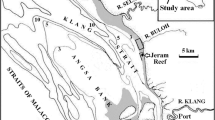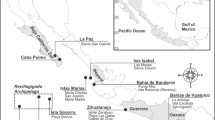Abstract
Large populations of flattened sponges with cyanobacterial symbionts were observed on the shallow reef-flats of the Flinders Reefs, Coral Sea. Estimates of these populations indicated as many as 60 individuals with a total wet biomass of 1.2 kg per m2 in some areas. Along a metre wide transect across 1.3 km of reef flat the population was estimated at 530 kg wet weight sponge (mean 411 g m-2). The four prominent species had instantaneous P/R ratios between 1.3 and 1.8 at optimum light such that photosynthetic productivity was calculated to provide between 61 and 80% of sponge energy requirements in summer and 48 to 64% in winter. While such sponge beds are a prominent feature of these reefs, they appear to contribute less than 10% of gross reef-flat productivity.
Similar content being viewed by others
References
Bennett I (1971) The Great Barrier Reef. Landsdown Press, Melbourne Victoria
Bertrand JC, Vacelet J (1971) L'association entre éponges cornées et bactéries. CR Hebd Séanc Acad Sci Paris D 273:638–641
Carpenter RC (1985) Relationships between primary production and irradiance in coral reef algal communities. Limnol Oceanogr 30:784–793
Chalker BE, Dunlap WC, Oliver JK (1983) Bathymetric adaptations of reef-building corals at Davies Reef, Great Barrier Reef, Australia. II. Light saturation curves for photosynthesis and respiration. J Exp Mar Biol Ecol 73:37–56
Chalker BE, Cox T, Dunlap WC (1984) Seasonal changes in primary production and photoadaptation by the reef-building coral Acropora granulosa, on the Great Barrier Reef. In: Holm-Hansen O, Bolis L, Gilles R (eds) Marine phytoplankton and productivity. Springer, Berlin Heidelberg New York Tokyo, pp 73–87
Daniel PA, DeVantier LM, Johnson DB, Barnes GR (1985) Flinders reefs. Studies in the assessment of coral reef ecosystems, vol 12. Australian Institute of Marine Science, Townsville, pp 1–40
DeVantier LM, Barnes GR, Daniel PA, Johnson DB (1985) Assessment protocol. Studies in the assessment of coral reef ecosystems, vol 1. Ausralian Institute of Marine Science, Townsville, pp 1–23
Dinesen ZD (1983) Patterns in the distribution of soft corals across the central Great Barrier Reef. Coral Reefs 1:229–236
Done TJ (1982) Patterns in the distribution of coral communities across the central Great Barrier Reef. Coral Reefs 1:95–107
Drew EA (1983) Halimeda biomass, growth rates and sediment generation on reefs in the central Great Barrier Reef province. Coral Reefs 2:101–110
Johannes RE, Project Symbios Team (1972) The metabolism of some coral reef communities: a team study of nutrient and energy flux at Eniwetok. Bio Sci 22:541–543
Jokiel P (1980) Solar ultraviolet radiation and coral reef epifauna. Science 207:1069–1071
Kinsey DW (1985) The functional role of back-reef and lagoonal systems in the central Great Barrier Reef. Proc 5th Int Coral Reef Symp 6:223–228
Raven JA, Glidewell SM (1975) Photosynthesis, respiration and growth in the shade alga Hydrodictyon africanum. Photosynthetica 9:361–377
Raven JA, Smith FA (1977) “Sun” and “shade” species of green algae: relation of cell size and environment. Photosynthetica 11:48–55
Reichelt RE, Loya Y, Bradbury RH (1986) Patterns in the use of space by benthic communities on two coral reefs of the Great Barrier Reef. Coral Reefs 5:73–79
Reiswig HM (1973) Population dynamics of three Jamaican Demospongiae. Bull Mar Sci 23:191–226
Reiswig HM (1981) Partial carbon and energy budgets of the bacteriosponge Verongia fistularis (Porifera: Demospongiae) in Barbados. PSZNI Mar Ecol 2:273–293
Rogers CS, Salesky N (1981) Productivity of Acropora palmata (Lamarck), macroscopic algae, and algal turf from Tague Bay reef, St. Croix, US Virgin Islands. J Exp Mar Biol Ecol 49:179–187
Sara M, Pansini M, Pronzato R (1979) Zonation of photophilous sponges related to water movement in reef biotopes of Obhor Creek (Red Sea). In: Levi C, Boury-Esnault N (eds) Biologie des spongiaires. Coll Int CNRS Paris 291:283–288
Stephens GC, Schinske RA (1961) Uptake of amino acids by marine invertebrates. Limnol Oceanogr 6:175–181
Vacelet J, Donadey C (1977) Electron microscope study of the association between some sponges and bacteria. J Exp Mar Biol Ecol 30:301–314
Vacelet J, Vasseur P (1977) Sponge distribution in coral reefs and related areas in the vicinity of Tulear (Madagascar) Proc 3rd Int Coral Reef Symp 1:113–117
Wilkinson CR (1978a) Microbial associations in sponges. I. Ecology, physiology and microbial populations of coral reef sponges. Mar Biol 49:161–167
Wilkinson CR (1978b) Microbial associations in sponges. III. Ultrastructure of the in situ associations in coral reef sponges. Mar Biol 49:177–185
Wilkinson CR (1979a) Nutrient translocation from symbiotic cyanobacteria to coral reef sponges. In: Levi C, Boury-Esnault N (eds) Biologie des spongiaires. Coll Int CNRS Paris 291:425–447
Wilkinson CR (1979b) Skeletal morphology of coral reef sponges: a scanning electron microscope study. Aust J Mar Freshwater Res 30:793–801
Wilkinson CR (1982) Significance of sponges with cyanobacterial symbionts on Davies Reef, Great Barrier Reef. Proc 4th Int Coral Reef Symp 2:705–712
Wilkinson CR (1983) Net primary productivity in coral reef sponges. Science 219:410–412
Wilkinson C, Garrone R (1980) Nutrition of marine sponges. Involvement of symbiotic bacteria in the uptake of dissolved carbon. In: Smith DC, Tiffon Y (eds) Nutrition in the lower metazoa. Pergamon Press, Oxford New York, pp 157–161
Wilkinson CR, Trott LA (1985) Light as a factor determining the distribution of sponges across the central Great Barrier Reef. Proc 5th Int Coral Reef Symp 5:125–130
Wilkinson CR, Nowak M, Austin B, Colwell RR (1981) Specificity of bacterial symbionts in Mediterranean and Great Barrier Reef sponges. Microbiol Ecol 7:13–21
Williams DMcB (1982) Patterns in the distribution of fish communities across the central Great Barrier Reef. Coral Reefs 1:35–43
Author information
Authors and Affiliations
Additional information
Contribution no. 352 from the Australian Institute of Marine Science
Rights and permissions
About this article
Cite this article
Wilkinson, C.R. Productivity and abundance of large sponge populations on Flinders Reef flats, Coral Sea. Coral Reefs 5, 183–188 (1987). https://doi.org/10.1007/BF00300961
Accepted:
Issue Date:
DOI: https://doi.org/10.1007/BF00300961




